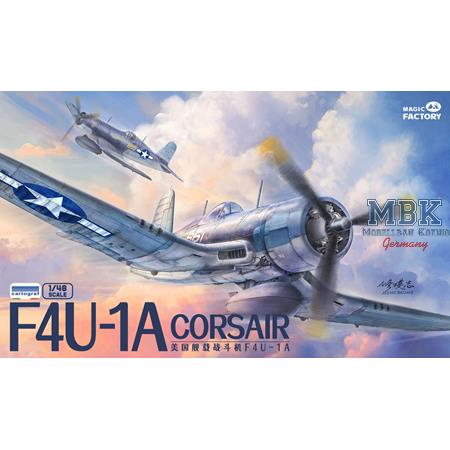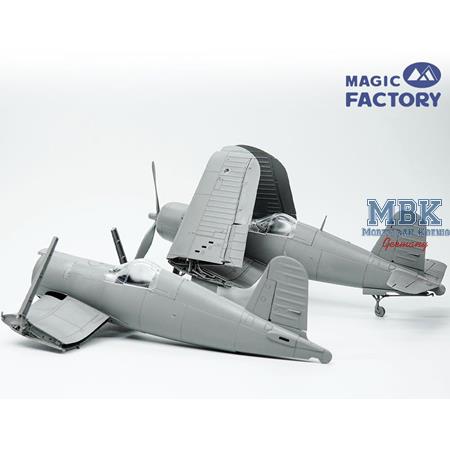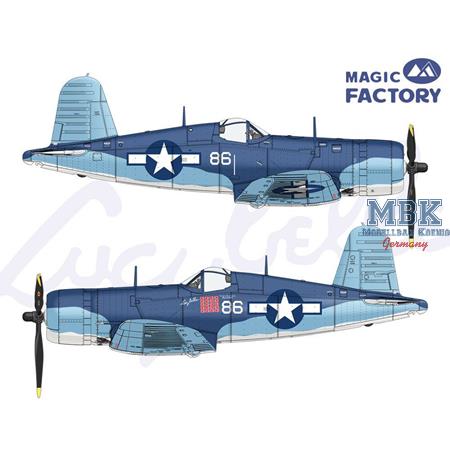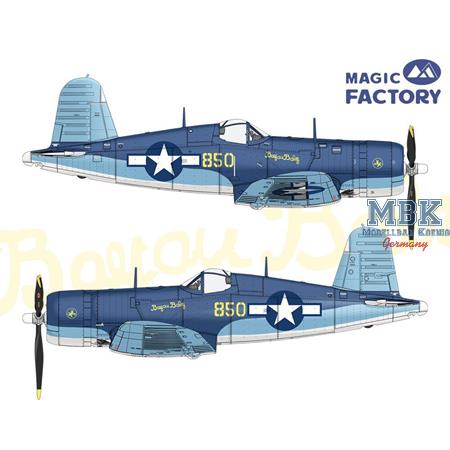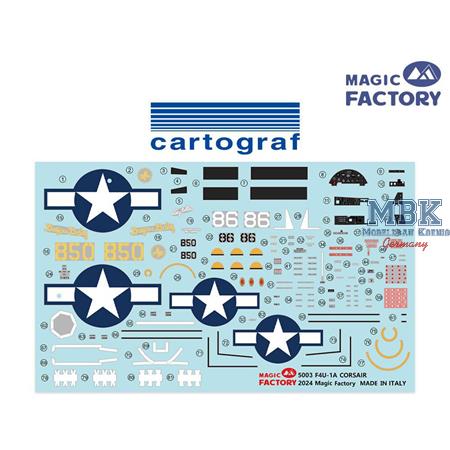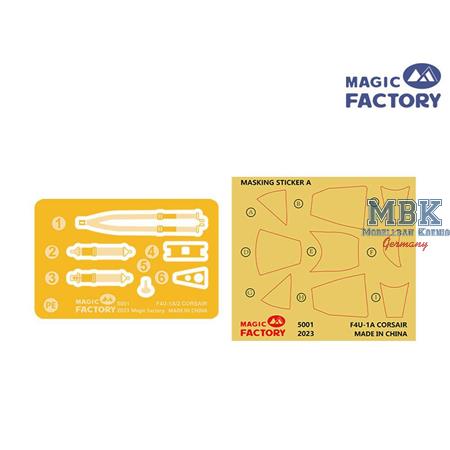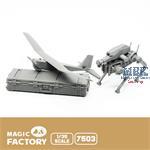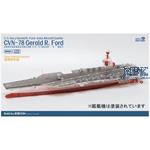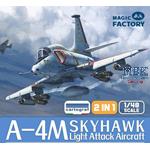Vought F-4U-1A Corsair (Single Version)
MGF5003
Magic Factory
1:48
- 1:48 scale
- many details - engine, landing gear bay, cockpit, weapon stations in the wings
- Clear, photo-etched parts and paint masks included
- Foldable wings to build
- 2 marking options
- unbuilt / unpainted
- Paint and glue not included
Howard Mayer, painted the original squadron logo and this drawing was sent to Disney Studio. However, Disney Studio drew up another insignia showing a bulldog in the ring instead of the rabbit.
The insignia then was sent to Leon Schlesinger Studio and Leon Schlesinger decided to use the Bugs Bunny in the ring and the squadron picked up the nickname as “Max’s Wild Hares”, also the name from the first squadron leader Major Max Read.
Due to lack of F4U Corsairs, the squadron did the training on the F4F Wildcat in most of time. On December 12, 1943, VMF-131 proceeded to NAS North Island and VMF-217 embarked on the USS Barnes(CVE-20) to Pacific Theater a week later. VMF-217 arrived Espiritu Santo on January 12, 1944,, continuing to Bougainville on January 28, 1944. 2 days later, VMF-217 began striking the bypassed Japanese garrison at Rabaul. The first victory went to 1Lt L.E Russell on the January 31, and 16 more claims during the Rabaul campaign and covering the Green Island landing.
From February through April the "Hares" lost 9 Corsairs, with four pilots dead or missing, to all causes. The flight echelon returned to Espiritu Santo on March 19, 1944 and remained until June 1, 1944 when they embarked on the USS Santee (CVE-29), USS Cetus (AK-77) and a few other ships for a voyage to Guam.
On August 4 VMF-217 was one of four MAG-21 squadrons flown ashore from the escort carrier USS Santee (CVE-29). Maj Jack Amende succeeded Read at year end, became the second squadron leader, and flying patrols and strikes in the Marianas until a new mission arose.
After extra training at Ulithi, stressing navigation, the "Wild Hares" joined VMF-216 aboard Wasp (CV-18) in February 1945.
Amende's pilots resumed scoring during the Tokyo strikes of February 16, 1945 - exactly one year after the previous combats at Rabaul. Five kills were credited in the Tokyo operation that cost skipper Jack Amende on the 17th. He was succeeded by Maj George Buck for the duration of the cruise.
On February 21 VMF-216 and VMF-217 provided direct air support to Marine infantry on Iwo Jima, strafing just ahead of the 4th Marine Division, repeating the process the next day. February operations cost five planes and two pilots besides Amende. In March VMF-217 lost one plane, with the pilot recovered. Late that month the flight echelon returned to Ewa, leaving some maintenance personnel aboard ship. In May 1945 the squadron returned to the United States, Marine Corps Air Station Santa Barbara, California, for reorganization and training for escort carrier duty. It was here that the squadron began training on the F6F Hellcat because all of the available F4U Corsairs were needed for anti-Kamikaze duty. Two junior officers took over Stateside in April and May before Maj Herb Peters arrived. He still had the squadron at El Toro in August 1945. At the time of the surrender of Japan they were attached to Marine Carrier Group 7 (MCVG-7) aboard the USS Point Cruz (CVE-119) and were preparing for another deployment. The squadron was deactivated at Naval Air Station San Diego on March 10, 1946.
VMF-217 was briefly reactivated from 1953 to 1964 in the Marine Forces Reserve, flying the A-4 Skyhawk at Naval Air Station South Weymouth, Massachusetts. In 1955, they were redesignated VMA-217. After deactivation, its assets were transferred to VMA-322.
Schreiben Sie jetzt Ihre persönliche Erfahrung mit diesem Artikel und helfen Sie anderen bei deren Kaufentscheidung

